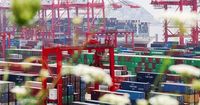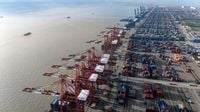China’s export juggernaut, which has powered the world’s second-largest economy for decades, unexpectedly hit a speed bump in October 2025. Official customs data released on November 7 showed that exports fell by 1.1% compared to a year earlier—the first such contraction in eight months and the weakest performance since February, according to Reuters. This reversal came on the heels of an impressive 8.3% growth in September, leaving many economists surprised by the sudden dip.
The headline figure masks a deeper story of shifting global demand, trade tensions, and the changing makeup of China’s export portfolio. Shipments to the United States, once China’s most lucrative market, plummeted by more than 25% year-on-year in October, as reported by Bloomberg. This marks the seventh consecutive month of double-digit declines in exports to the U.S., a trend that has weighed heavily on China’s overall trade performance.
While shipments to all nations except the U.S. actually rose by 3.1% in October, according to Bloomberg, this uptick was not enough to offset the dramatic drop in U.S.-bound goods. The export contraction also comes against a high base from October 2024, when exports soared by more than 12.6%, the fastest rate in over two years, as noted by the Associated Press.
What’s behind this sudden reversal? Several factors are at play, and they paint a picture of an economy grappling with both external and internal pressures. For one, the ongoing trade war with the U.S.—which saw the imposition of steep tariffs, including the so-called “Liberation Day” tariffs in April 2025—has fundamentally altered trade flows. After months of Chinese exporters front-loading shipments to beat tariff hikes, October’s data suggests that this effect has faded. "It appears the rush to ship goods to the U.S. ahead of tariff hikes subsided in October," Zhang Zhiwei, chief economist at Baoyin Capital Management, told Reuters.
Yet, the story is not solely about the U.S. China has worked hard to diversify its export markets, increasing shipments to regions such as Southeast Asia, Africa, and Latin America. Exports to Southeast Asia grew by 11% in October, and to the European Union by 0.9%, according to Reuters. However, no other single market comes close to matching the sheer scale of the U.S., which still accounts for more than $400 billion in annual Chinese exports. Economists estimate that the loss in U.S. trade has shaved about two percentage points off China’s export growth, equivalent to roughly 0.3% of GDP.
Adding to the complexity is the changing nature of what China is exporting. The country has leaned into products like cars, solar panels, and batteries—sectors where prices have come under significant pressure. The New York Times reported that while the number of exported cars rose nearly 25% in October compared to a year earlier, the value of those exports increased by only 17%. This suggests that Chinese companies are offering deep discounts to overseas buyers, in part to offload excess factory capacity at home.
“Falling prices for key exports such as batteries, cars, and solar panels contributed to the decline in export value,” Semafor noted, even as the physical volume of exports continued to rise. This discounting strategy has helped Chinese exporters maintain market share but has also weighed on the overall value of exports.
There are also signs that Chinese companies are finding creative ways to sidestep U.S. tariffs. Zichun Huang, a China economist at Capital Economics, observed in a research note that "a rise in the share of Chinese exports going to Vietnam, the top rerouting hub, suggests that the tariff offset from rerouting continued to expand." This means some goods are being shipped through third countries before reaching the U.S., blunting the impact of tariffs. Even so, the drag from U.S. tariffs appears to be moderating rather than increasing, with exports to the American market falling less in October than in the two previous months, according to The New York Times.
Despite the export stumble, China is still on pace for a second straight year of record trade surpluses. In October, China’s trade surplus with the U.S. actually rose to $24.76 billion, up from $22.82 billion in September, as reported by Reuters. This large surplus has helped Beijing maintain factory employment and stabilize the broader economy, even as a protracted property sector downturn and weak domestic consumption continue to pose challenges.
Indeed, the domestic picture remains fraught. Imports grew by just 1% in October, the slowest pace in five months and a sharp deceleration from the 7.4% growth seen in September, Reuters reported. While imports of soybeans, crude oil, and iron ore rose—driven by competitive prices and a rush to buy before potential price spikes—copper purchases dropped, reflecting continued weakness in the construction sector amid China’s housing market slump.
Consumers in China have been cautious about spending, having lost significant portions of their life savings in the property downturn. This has prompted policymakers to emphasize the need for boosting household consumption. Officials recently announced plans to raise the share of consumption in GDP "significantly" over the next five years, underscoring the government’s recognition that export-led growth alone may no longer be sufficient.
Currency movements have also played a role. The renminbi strengthened slightly against the dollar in recent months, making Chinese goods more expensive in some overseas markets. However, it weakened by about 7% against the euro over the past year, which has helped exports to the European Union, The New York Times noted. Following the release of the October data, the yuan edged lower against the dollar, registering its first weekly decline in a month, according to Reuters.
Amid these challenges, there are glimmers of hope. The trade truce agreed by Presidents Donald Trump and Xi Jinping in late October, which saw both sides agree to lower tariffs and postpone new port fees, has eased trade tensions—at least temporarily. China also paused some export controls on rare earths for a year and agreed to buy more U.S. farm products, while the U.S. eased some sanctions on Chinese companies, as reported by the Associated Press.
Economists at Goldman Sachs are cautiously optimistic, predicting that Chinese export volumes could grow by 5% to 6% annually as the effects of the truce take hold. But, as Leah Fahy and Zichun Huang of Capital Economics noted, any export boost from the tariff reductions is unlikely to show up until later in the last quarter of 2025, with a more "meaningful" increase expected in the first and second quarters of 2026, according to Wei Li of BNP Paribas Securities (China).
As Chinese Premier Li Qiang told business leaders at the China International Import Expo in Shanghai on November 7, China will “embrace free markets and free trade,” while criticizing trade restrictions that hurt developing countries. Whether this rhetoric translates into a sustained rebound in exports remains to be seen, but one thing is clear: China’s export machine is facing a new era of uncertainty, and the world is watching closely to see how it adapts.

